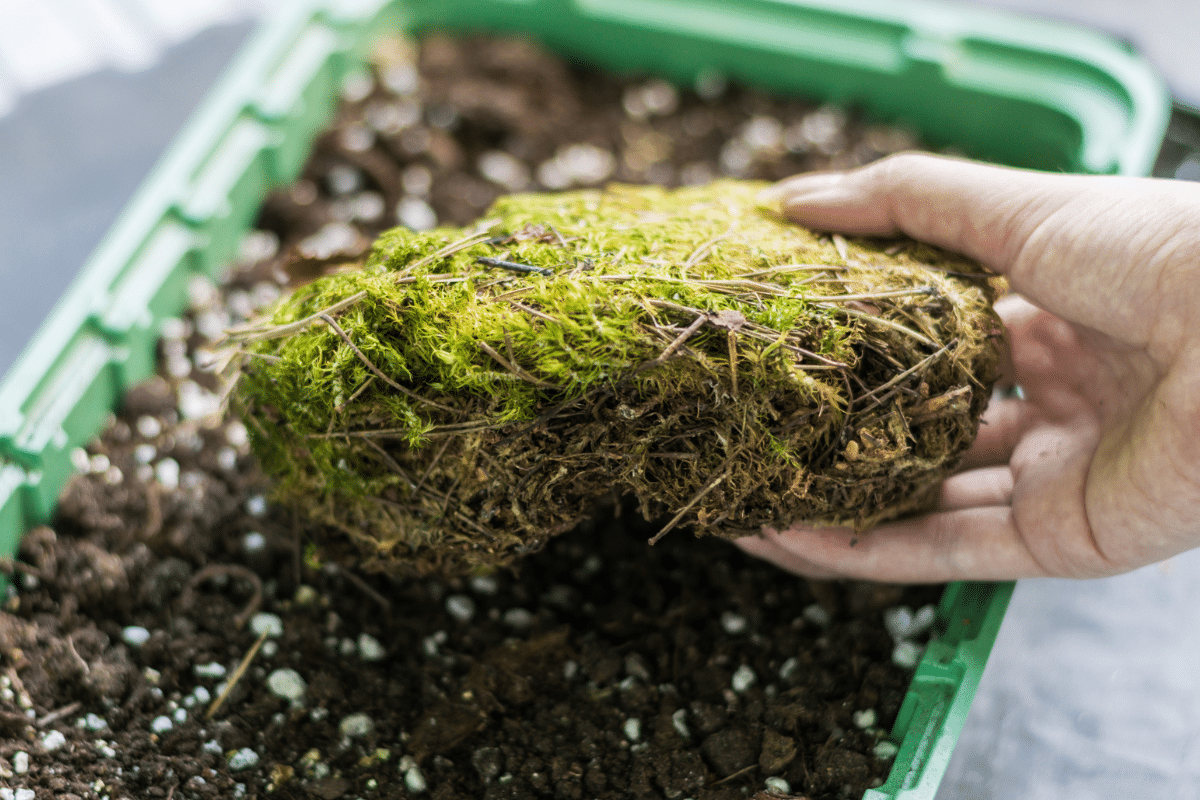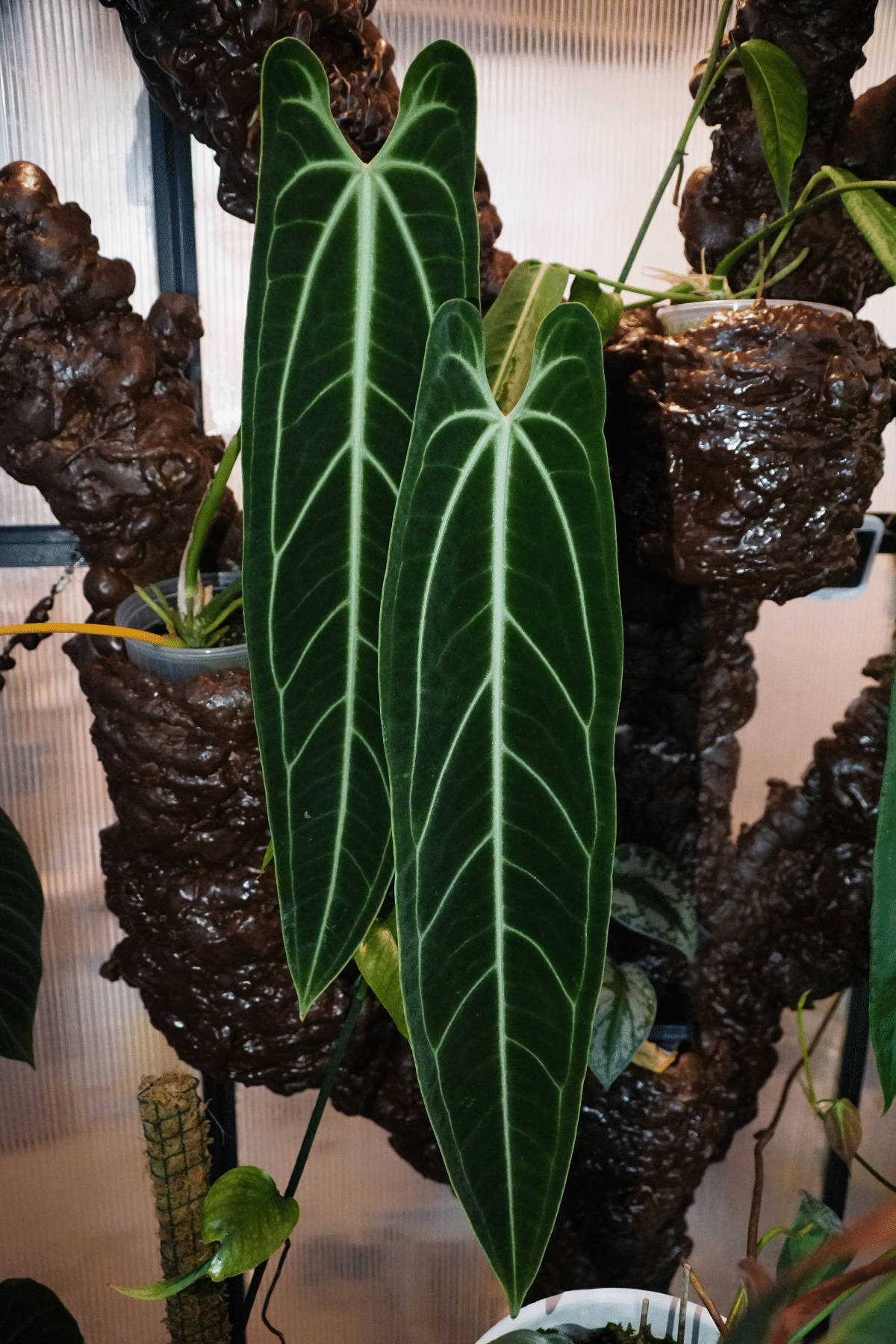Anthurium Clarinervium, also known as Velvet Cardboard Anthurium, is an excellent houseplant that can surely elevate the greenery of your indoor space. Its dark heart-shaped leaves with contrasting white veins make it look luxurious, but surprisingly, this plant is pretty easy to care for.

Once you learn how to care for your Anthurium Clarinervium plant, you’ll be able to successfully maintain this head-turning foliage.
Jump to:
Features And Characteristics
Growth Habit
The Anthurium Clarinervium doesn’t usually grow beyond 30 inches, both in height and width. With a slow growth rate, it takes approximately 5 to 8 years for this plant to reach its mature size. So, during the initial years, it maintains a compact appearance, making it an ideal choice for indoor cultivation or even as a centerpiece for your coffee table.
Lifespan
The Anthurium Clarinervium is one of my longest-living indoor plants. With proper care, they can live for over ten years, which is double the average lifespan of most houseplants.
Flowers
Although they’re mainly loved for their lush leaves, Anthurium Clarinerviums also bloom flowers. Similar to many other members of the Anthurium family, this plant produces Spadix flowers accompanied by spathes of similar color during spring and summer.
Leaf Patterns And Appearance

As a member of the Anthurium genus, the Velvet Cardboard Anthurium stands out with its dark green leaves that possess a unique velvety texture. These heart-shaped leaves feature delicate white veinlets and grow to a length of approximately 6 to 10 inches.
Anthurium Clarinervium Care Tips
Here are the must-know tips to properly care for Anthurium Clarinervium plants.
Potting Soil
Since Anthuriums are epiphyte species that naturally grow by clinging to other plants in nature, it’s important to use an Anthurium Clarinervium soil mix that is extremely well-draining. In fact, the potting mix you use doesn’t even have to be primarily made of soil.

For the soil of my Velvet Cardboard Anthurium, I combine pine or orchid bark, sphagnum moss, perlite, and fresh soil. This mixture provides excellent air circulation and drainage for the plant’s roots, which is exactly what it has in its natural habitat.
Light
The Velvet Cardboard Anthurium thrives in bright, indirect light or filtered sunlight. So, as much as possible, ensure your plant is away from direct sunlight exposure. During winter, however, feel free to expose your Anthurium Clarinervium to direct sun for an hour or two daily.
Watering Needs
In the rainforest, Anthurium Clarinerviums receive frequent rains but dry out quickly as their roots have good airflow. This is exactly the watering condition you’ll want to replicate for your tropical plant to thrive.
Re-water your Anthurium Clarinervium when the top of the soil is dry while the bottom remains lightly moist. Use your finger to gauge the moisture in the top inch or two of the soil to determine if it’s the right time to water.
Generally, you’ll need to water your plant every 5 to 7 days. However, during winter, you may not need to water it as frequently.
Pro tip: It’s best to use rainwater to water your Velvet Cardboard Anthurium, but purified or distilled water also works fine. If possible, avoid using tap water, as it could potentially slow your plant’s growth.
Temperature
The Anthurium Clarinervium prefers warm temperatures ranging from 65ºF (18ºC) to 80ºF (27ºC). Avoid exposing your plant to environments that are too hot or cold, as extreme temperatures often have visible unwanted effects on your plant.

Humidity
This plant thrives in high humidity levels ranging from 40% to 60%. If your room lacks sufficient humidity, consider placing a humidifier a few feet away from the plant. Avoid spraying your Anthurium Clarinervium with a plant mister to increase humidity. The Anthurium genus is highly susceptible to fungal growth when its leaves remain moist for extended periods.
Note: You may use a hygrometer to monitor whether your house meets these humidity levels.
Fertilizer
The Velvet Cardboard Anthurium grows best when fertilized sparingly during its growing season. This means feeding your plant every four to six weeks during the spring and summer months.
The Anthurium Clarinervium may burn its roots when fertilized too much or often. So, it’s best to use only half the recommended strength of your plant food.
Flush the soil of your plant every quarter of the year to avoid salt mineral buildup caused by the fertilizer. To do so, continuously water your plant’s soil for two or three minutes.
Repotting
For new plants, repotting should be done yearly to ensure your Anthurium Clarinervium has enough space to grow. As your plant matures, repotting can be done more sparingly, every two to three years.

The best time to repot your plant is in spring before your Anthurium’s growing season starts.
Propagation Techniques
I’ve successfully tried Anthurium Clarinervium propagation in two ways: through division and stem cuttings. I’ll explain how to do each process below. However, before proceeding, note that propagation should only be done on mature plants at least 1 or 2 years old.
Division
The division is a convenient propagation method if you’ve already planned to repot your plant. It involves removing your entire Velvet Cardboard Anthurium from its pot and dividing it into smaller stem sets, each with healthy roots and at least one leaf.
Once divided, you can plant each stem set on its own using the same soil mix recommended above.
Stem Cuttings
Propagating Anthurium Clarinervium through stem cuttings can be a bit trickier. However, this method is handy if you prefer not to remove your plant from its pot.
To propagate through stem cuttings, find a pup that’s at least 2 inches long from your mother plant. Ensure it has some aerial roots attached, then using a sharp knife, separate the base of the pup from the rest of the plant.
Allow your newly cut stem to callus for at least a couple of days by keeping it in a warm room. Then, plant it in a pot with a proper drainage hole and a suitable soil mix.

From here on, feel free to care for the plant as you would for a fully grown Anthurium Clarinervium.
Common Problems And Fixes
Common Anthurium Clarinervium problems aren’t usually life-or-death situations for your plant. However, when they do happen, it’s best to make the necessary adjustments ASAP to keep your plant healthy.
Diseases
Yellow Leaves
Stress is the primary cause of Clarinervium plants’ leaves turning yellow. While you may initially think it’s due to underwatering, it’s not that simple. Overwatering, underwatering, and excessive temperatures can all contribute to this problem.
The only effective way to address this issue is to monitor every factor that affects your plant. Ensure to provide it with enough, but not too much water, and double-check that your potting mix and pot allow proper drainage.
Additionally, ensure that the plant is placed in a warm room that is never too hot or cold.

Brown Leaf Tips
Low humidity is the leading cause of browning at the tip of your Anthurium Clarinervium’s leaves. So, ensure that you provide your plant with at least 60% humidity. If its leaves still continue to develop brown tips, consider moving the plant to a room that’s more humid. Your plant would love that better.
Dull Leaves
A dull leaf color indicates that your plant is not getting enough light. So, relocate it to a place that receives plenty of medium to bright but indirect sunlight. If you find it hard to find a suitable spot, consider using grow lights.
Pests
Mealybugs
Mealybugs are notorious for infesting indoor plants. These white, cotton-looking creatures feed on the nutrients of your leafy family. If left untreated for long periods, they can even cause the death of your plant.
Luckily, removing them is easy. Dampen a cotton swab with isopropyl alcohol and use it to remove the mealybugs from your plant’s stems and leaves.
Brown Scales
Brown Scales are pests that also commonly infest Anthurium Clarinervium plants. These pests have a mosquito-like habit of extracting sap from the plant using their piercing mouthparts. Although they rarely cause plants to die, they can cause your Anthurium Clarinervium to wilt or lose its vibrant green color.
Neem oil is a great natural remedy for controlling Brown Scales. Dilute it according to the instructions on the product and apply it to your plant’s affected areas using a spray bottle or a soft cloth.
Other Anthurium Varieties
If you’re interested in raising other foliage that looks like Anthurium Clarinervium, these are some of your best options:
Anthurium Crystallinum

Another stunning house plant that thrives indoors and features white veinlets on its leaves is the Anthurium Crystallinum. Compared to Clarinervium, this plant has thinner, lighter, and narrower leaves. It only reaches 25 inches in height, making it a great choice if you prefer compact-sized plants.
Anthurium Warocqueanum

This is, undoubtedly, one of my favorite large-sized houseplants. Both its stems and leaves can grow up to 4 feet tall indoors, which makes it a great statement piece to add a touch of tropical elegance to any room.
FAQs
Anthurium Clarinervium can survive in low light conditions, but may not produce flowers without adequate sun exposure.
Yes, Anthurium Clarinervium is well suited for indoor cultivation. As long as you meet its care requirements, there’s no problem growing this plant inside your home.
Yes, Anthuriums Clarinervium can grow without soil. One of the best alternative ways to cultivate this plant is through hydroponics, which involves growing your plant in rich water solution instead of soil. Another great medium to grow your Anthurium plant in is sphagnum moss.
Elevate Your Home with Green Charm
Anthurium Clarinervium is a stunning foliage plant that excels in making any space feel more connected to nature. This plant can be a delightful visual treat year-round for you and your family. However, before deciding on bringing it home, ensure you’re fully committed to providing the Anthurium Clarinervium the houseplant care it needs.

After all, while this plant is not too complicated to grow in your home, it’s also not too forgiving regarding its environment and care. It has specific requirements for light, humidity, and water that must be met for it to thrive.


